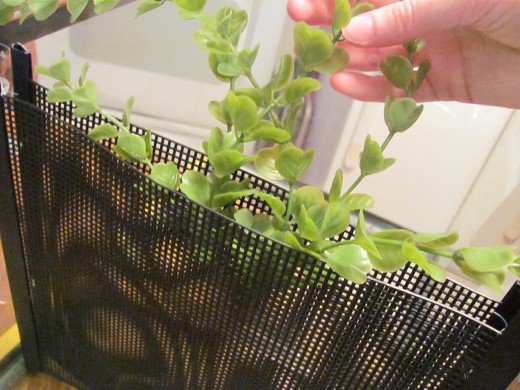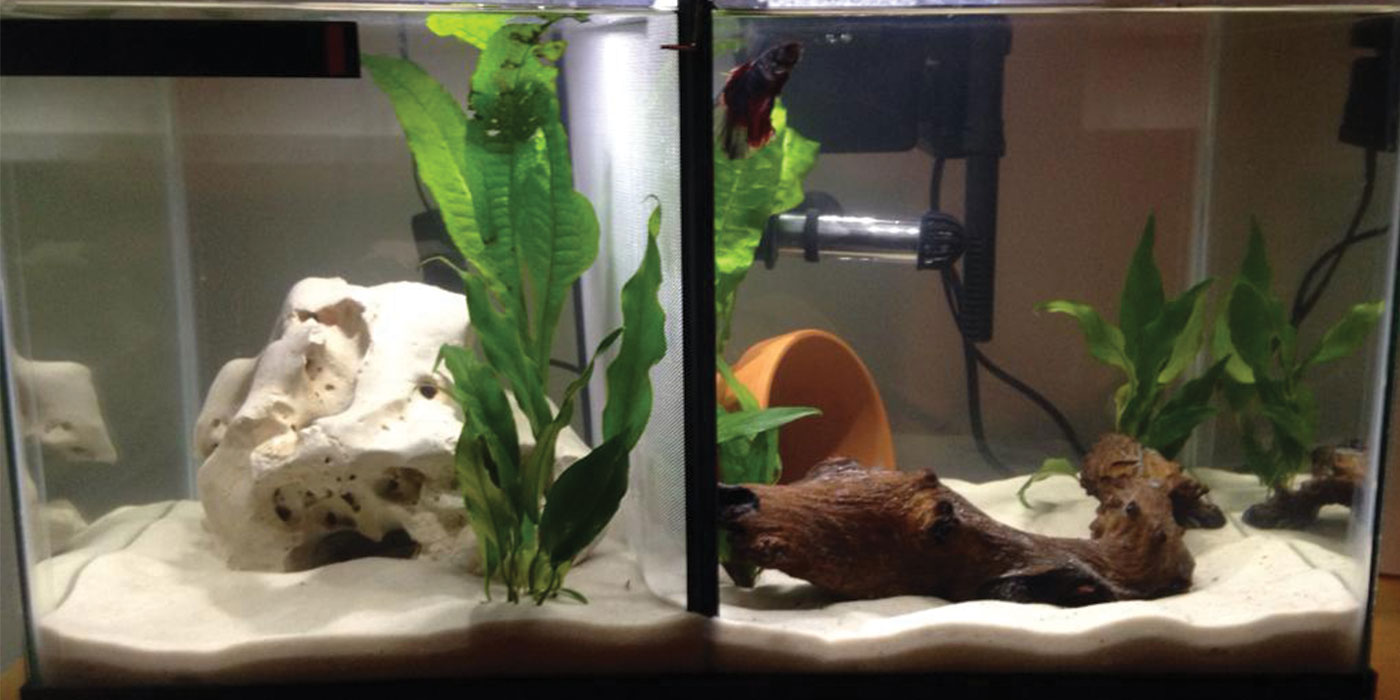If you want more than one betta fish in a single tank, a divided betta tank is a great option for males and females. While there are pros and cons, this option for a caretaker is much easier than maintaining several five gallon tanks, which is the recommended size for a single betta fish. Unless you’re caring for a sorority of females you cannot house more than one betta fish without the risk of immediate injury or death. They’re fighter fish.
If you decide to divide a tank, it must provide the proper ecosystem for each betta fish. What does that mean? A ten gallon tank should be divided into two separate five gallon sections, a twenty gallon should be divided into four ecosystems, and so on. The photo above is a great example of a divided ten gallon tank by Reddit user Oluja. While this method allows for housing many betta fish with less footprint, we do not support any tanks or sections that restrict the recommended size for a healthy betta fish.
Betta Tank Divider
There are multiple choices when it comes to dividing a betta tank. You may purchase one that is already divided with silicone-sealed glass sections, purchase an aquarium divider system (affiliate link), or opt for a do it yourself solution. The goal is to use one heater and filter, while allowing for water transfer between the sections, and reducing or eliminating visibility between each betta.
If visibility between each section is not controlled, one fish (or both) could become extremely agitated and aggressive. After non-stop flaring, refusal to eat, and attacks at the divider, the betta could become so stressed they eventually die. Even a mesh divider is not enough, you also have to provide plenty of plants and decorations for reduced visibility and areas to hide. Without that, a betta fish may never feel safe.
The DIY Solution
Most hobbyists love a good do-it-yourself solution and I do too. The best tanks to divide are long and shallow tanks. Don’t divide tall tanks. You can find plastic canvas mesh at craft stores, Wal-Mart, or online. They are most commonly used for needlepoint projects.
This canvas is perfect for making effective dividers and you can find it for well under ten bucks for a single sheet. You’ll probably want more in case you mess up the first time though. Make sure you measure your tank and get larger than necessary sheets because you can trim them to fit.
(affiliate link)
Next you’ll need to purchase binder report splines to anchor the plastic mesh on each side of your tank. These splines are also very inexpensive and can be found at Wal-Mart or other office supply stores like Staples. If you can find the splines separately, purchase them because you won’t need the clear report covers.
Each spline should be cut to fit firmly under the lip of each side of your fish tank. You may also use aquarium silicone sealant if you’d like a more permanent means of anchoring each spline. If your splines or divider fails you will have a big problem on your hands, so take your time and do it right. You don’t want either fish getting into each other’s side of the tank.
(affiliate link)
Things to Consider
Since you’ll be trimming the mesh, make sure you don’t leave any jagged edges anywhere that could rip your betta’s fins. Using a binder spline on the sides and bottom should help to cover any jagged areas. You can also use substrate along the bottom to build up above the base.
I’m a big proponent of less visibility when it comes to each fish too. Stress can lead to sickness and disease. You can purchase darker colored plastic mesh or even double it up for extra caution. Place large, medium, and small-sized plants and decorations up against the mesh to add further coverage and reduce visibility to each other.
Center Divider Compartment
Another divided betta tank solution which works really well is to create two divisions near one another with a small one to two inch space in the middle where plants or even your heater can be added inside. A picture is included below for your reference. This doubles the division layers, allows for plants to be easily tucked inside and increases the barrier distance between each side.

Betta fish are also very good jumpers. Remember this when you are creating your divider and when you are monitoring the level of water in your tank. A divider that is not high enough or water level that allows a betta to easily jump and clear a divider is trouble. If there’s a way to get at the other betta, they will find it. Don’t give them an option.
Divided Betta Tanks and Disease
Betta fish tanks that are divided reduce maintenance because you only need to clean one tank, add water conditioner to one tank and so on. They do however increase the risk and spread of betta fish diseases. For that reason you should have a quarantine tank in case one betta contracts a disease. They share the same water and one betta could easily infect the other.
If you’ve purchased a new betta, always follow a proper quarantine and acclimation routine before adding them to your divided tank. Betta fish are notorious for infections and diseases when purchased from pet stores because of their prior care. Resist the urge of immediately introducing them into the other side of your tank.
Larger Tanks are Better
When I say larger I mean water capacity or volume, not height. Betta fish thrive in long shallow tanks because they most adequately mimic their natural habitat. They live in shallow tropical waters and need to get to the surface for air. Larger tanks are easier to maintain water parameters and allow for divisions that can also include other community members.
At some point you’re going to want a tank mate for your betta like a snail, or school of neon tetras. This gets challenging if you only have a ten gallon divided tank. For example, the bioload in each 5 gallon section would be high and the size too small for a school of neon tetras.
A 20 gallon long and shallow tank could be ideal for two 10 gallon divisions with community members accompanying each betta fish on each side. Community members can take your tank to the next level, especially if your betta is on the docile side and plays nice.
Monitor Divided Betta Tanks
After dividing your betta tank you should monitor it closely for a few days to see how each betta responds. The more visibility they have to one-another the more risk there is for problems. Check daily for any openings or breaks in the divider. Make sure you keep the water level a couple inches lower than the tallest part of the divider to prevent jumps across.
Keep a cup or your quarantine tank close by in case one does manage to get into the other side (betta fish are curious). If you’re lucky you’ll be able to net one before anything disastrous happens. If after a week or two one or more are constantly flaring, agitated and stressed out still, consider reducing visibility and adding more hiding spots. After that time-frame you should be all set if both fish are eating and healthy.





This really help me understand the pros and cons of getting a split tank for betta fish.